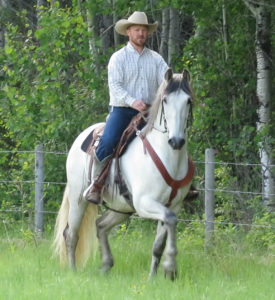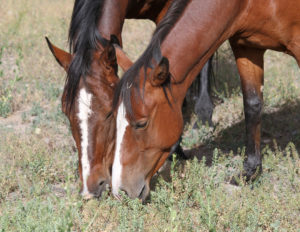In my last two posts, we looked at what I call “emotional horsemanship” and why that is often problematic. Today I’d like to talk about another common style of training that could be described as “dictatorial horsemanship.”
Dictatorial horsemanship interprets equine relationships as primarily hierarchical, with every horse having a rank in the pecking order. The highest-ranking horse, often called the alpha, is thought to be the leader, and the principle goal of this style of horsemanship is to become the alpha by showing the horse that we are the boss and making it respect us. This is typically accomplished by driving or moving the horse, often fairly aggressively, and continuing to apply pressure until the horse “shows submission” by lowering its head, licking and chewing, following you around, or some other sign that is thought to imply that the horse now sees you as the leader.
While this style of horsemanship can certainly teach a horse to do any number of things, there is often something lost in a horse that is trained this way, something I consider precious and worth preserving. Call it life, spirit, or something else, but when it is gone, what you will see is a shut-down horse with a dullness of expression that equine ethologists now recognize as a form of depression. It’s like a light has been switched off inside of these horses, and they just go through the motions of whatever they are asked to do for the sake of self-preservation.
In reality, horses are no happier under the rule of a dictator than people are. The reasons for this become clear when we understand that equine relationships are actually far more cooperative and less hierarchical than most of us have been led to believe, and that “rank” in the pecking order does not necessarily correspond with “leadership”. Research into the social behaviors of wild horses has shown that in a natural herd, aggressive, bossy horses may hold the highest rank (as determined by who gets first access to scarce resources), but these horses are often not the leaders, meaning the ones who head off to find better grazing, sources of water, etc., and get followed by the others.
The leaders (and there is often more than one) are typically quiet, calm individuals who simply go about their business in a way that has proven to convey benefits to those who stay with them. The rest of the herd will choose to follow and stay near those who help them meet their needs, but will actually try to keep away from the aggressive, selfish ones whenever possible.
Of course, in a training situation, the horse does not have the choice to avoid the trainer, so if that trainer takes on the position of an aggressive, high ranking horse by applying pressure in a manner that demands submission, the horse is not going to feel very good about the situation, though they will eventually comply when they learn there is no reprieve otherwise. People may believe they are giving the horse a choice by forcing them to either continue to get chased, moved and pressured, or to give up so that they can get some relief, but from the perspective of a horse, that is truly being caught between a rock and a hard place.
Since the horse’s most basic need is to remain safe, forcing the horse to choose between risking exhaustion (which leaves it highly vulnerable to predators) or begging for relief from a relentless source of pressure offers no positive options – and I don’t believe this is the best way to foster a trusting relationship.
 The life in the horse is something I consider precious and beautiful, so I strive extremely hard to preserve it.
The life in the horse is something I consider precious and beautiful, so I strive extremely hard to preserve it.

Wild horses, like the two pictured here, form close relationships that are based much more on cooperation and companionship than on hierarchy.
Josh Nichol

Great article. Thanks for the information.
Nicely said Josh. Makes total sense. I wish more people would see it this way…hopefully with people like yourself educating us, more and more people will understand the way of the horse and how to have healthy relationships with our horses. Really its a win win when they do.
Yes, yes, yes! Great article, Josh! One experience with my herd was when the lead mare lost her sight. It did not change her position as lead mare, which I found to be totally amazing. Ladyhawke always would lead off for water, when I called them or to go back out to pasture etc. She was absolutely amazing and unless you knew she was blind it was impossible to tell. Learned a lot from that mare. I have also noticed that if you have benevolent “bosses” you will have a very peaceful herd, but when you have “bossy, picky bosses”, the herd tends to be very unsettled. Makes sense to me.
Love your blogs!
In my experience, most horses are extraordinarily cooperative in what we ask them to do. So they are already mostly there. The reasons they may not cooperate include physical pain (their body cannot do it ), confusion about what we are asking, or fear (when their survival instinct kicks in). In what I understand of relational horsemanship, we leave them a space to express their opinion and then to contribute to what we are doing by acts of their choice. This creates a synergy that is more than the initial request. With dictatorial horsemanship, the amazing capacity of the horse to contribute on its own is blocked and as a result there is something valuable missing, for both the person and the horse. I know from repeated instances how important it is for my own horse to feel heard and listened to. Although it takes more time and asks more of me I would not want to be without that piece of our relationship and the richness that comes with it.
A great read! Funny enough my gelding Invicto is a dictatorial leader over my mare. Horses have horsemanship styles too! She used to be the boss over Invicto and was the calm confident leader you describe. She is a Mustang and was a leader in the herd when she was captured at age 5 in Oregon. Once Invicto turned 4 he became more assertive and now at 6 he is pretty annoying and drives her off any food pile even if there are many. She will not fight with him but also does not push off easy so she has some bite marks on her. He puts his heart and soul into driving her off. I am hopeful now that I have more time I can help him with his strong thoughts of what he thinks he needs to do and show him a style of leadership that is calmer, leading by example, go with me in united strength rather than get away from my pressure. Will see where that goes.
Hi Claudia. You are absolutely right that horses have different interaction styles. What I would say is that Invicto has become what researchers refer to as a “high ranking” horse, but they differentiate that from a “leader”. Leaders teach by example, for the most part. High ranking horses push others around, often in relation to resources (even when, as you say, there are plenty of piles).
An excellent article. I think it comes down to feel. How do you feel about your horse, how do you think they feel about you. I have found some horses will certainly go through the motions but they are not with you. Another thing I have noticed of late is that my horse seems a bit sullen and out of sorts. However she is quiet, willing and remains very sensitive to all asks. She does not seem to have a thing physically wrong with her. I just try to understand she doesn’t always have to be her cheerful self and spend a bit of extra time scratching and grooming her. I think humans are hard wired to want a partner/companion and not a slave. I don’t know where we went wrong on this. Maybe fear of things larger and stronger than us.